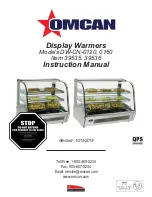
Page 5
CLEANING
WARNING-
ELECTRICAL SHOCK COULD OCCUR
• Electrical components of unit could be
damaged from water exposure or any liquid.
• Never immerse unit into water or any liquid.
• Never use any water jet or pressure sprayer
on unit.
• Ensure unit is “OFF” and unplugged.
CAUTION- HOT
Allow unit to cool before cleaning.
CLEAN VESSEL,
INSET & LID
• Before first use and after use daily,
disassemble and clean unit.
• Ensure unit is “OFF” and unplugged.
• Wash with dishwashing soap and hot water.
1
RINSE
fully with clear water.
2
SANITIZE
all parts according to local
sanitization requirements. All parts in contact
with food must be sanitized.
3
DRY
all parts fully with a clean soft cloth.
4
CLEAN EXTERNAL SURFACES
• Wipe daily with a clean damp cloth.
• Dry with a clean soft cloth.
• Glass and surface cleaners approved for use
in food contact areas may be used.
5
• A mildly abrasive nylon or brass brush may
be used to remove any stubborn food or
mineral deposits on interior surfaces of unit.
• Fully rinsing and drying all parts can help
prevent corrosion. Elements and minerals in
tap water can accumulate on stainless steel
parts and create corrosion.
• Do not use abrasive, caustic or ammonia
based cleansers.
• Do not use products containing acids,
alkalines, chlorine, or salt. These agents can
corrode stainless steel.
• Do not use metal scrapers or cleaning pads
that could scratch surfaces.
This warmer, water vessel
and food inset with lid are
constructed of stainless steel—
one of the best materials for food
serving and storage.
If you notice corrosion beginning on
any stainless steel surface, you may need to
change the cleansing agent, sanitizing agent, or
the cleaning procedures you are using.
CARE OF STAINLESS STEEL


























